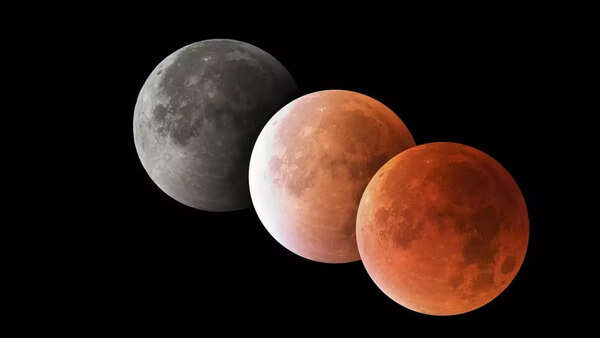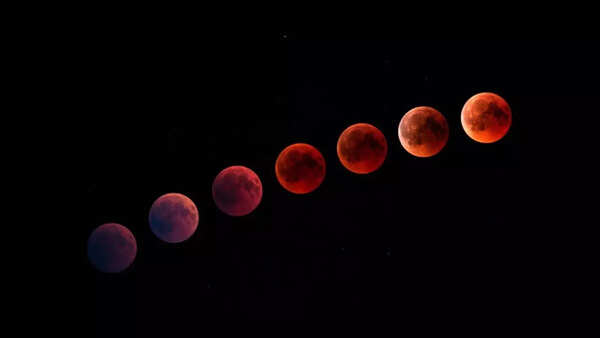Trending
Blood Moon 2025: Best timings to spot the Lunar Eclipse according to USA time zones (ET, PT, CT and more)
This March's total lunar eclipse, first in two years, will turn the moon a striking rusty-red. Occurring March 13-14, 2025, phases will be visible across all US time zones. Optimal viewing suggests dark environments away from city lights, though binoculars improve the experience.
Although the moon has its reputation for stealing all the glory of the night sky, this March - it is set to become a tad bit more striking. This March, thanks to the Lunar Eclipse, the moon will be sporting a rusty red aura instead of the pearly/silvery one.
What is a ‘blood moon’?
A ‘blood moon’ is a popular term for a total lunar eclipse when the moon appears rusty red or ruddy brown in color.
A total lunar eclipse is coming to Earth for the first time since 2022. On the night of March 13-14, 2025, North America and South America will get a great view of all phases of a ‘blood moon’.

When will the blood moon occur?
According to Timeanddate.com, the lunar eclipse will happen in five stages between 11:57 p.m. and 6 a.m. EDT (03:57 to 10:00 UTC).
The first stage begins when the moon moves into Earth's fuzzy outer shadow, its penumbra, and loses its brightness. It then enters the umbra, and gradually turns reddish as the line of Earth's shadow moves across the moon.
According to NASA, if you live in the U.S., you can see the eclipse starting at about 11:57 p.m. EST when the penumbral phase begins as the moon enters the outer part of the shadow and begins to subtly dim.
At 1:09 a.m., a partial eclipse begins as the moon enters Earth's umbra and starts to darken. To the naked eye, the moon should look like a bite is being taken out of the lunar disk.
What you don’t want to miss, is the phase of totality when the entire lunar surface will appear reddish, becoming a true blood moon. Halfway through that 65-minute period, the event starts to run in reverse, with the moon gradually slipping out of Earth's umbra, then penumbra, before finally returning to its regular bright, white-gray color.
Totality occurs at 2:26 a.m. when the entire moon is under the umbra. This is when the reddish hues of the "blood moon" will be on display.
As the moon exits the umbra by about 3:31 a.m., the red color will fade and another bite-like display, this time on the other side of the moon, will appear. As NASA explains, the entire eclipse process is projected to end by 6 a.m. as the moon slowly exits the Earth's penumbra.
Now, there are actually six time zones in the USA. The four main ones are Eastern, Central, Mountain, and Pacific Standard Time. The two others are Alaska Standard Time and Hawaii-Aleutian Standard Time, observed only by Alaska and Hawaii respectively.

Eastern Time (EDT): Penumbral phase began at 11:57 PM on March 13, partial at 1:09 AM on March 14, totality at 2:26 AM, and partial at 3:31 AM. There are 22 states in the Eastern time zone: Maine, Maryland, Massachusetts, New Hampshire, New Jersey, New York, Connecticut, Delaware, Georgia, North Carolina, Vermont, Virginia, West Virginia, Ohio, Pennsylvania, Rhode Island, South Carolina, Michigan, Tennessee, Florida, Indiana and Kentucky that can witness the blood moon at that time.
Central Time (CDT): Penumbral phase began at 10:57 PM on March 13, partial at 12:09 AM on March 14, totality at 1:26 AM, and partial at 2:31 AM. States like Alabama, Arkansas, Illinois, Iowa, Kansas, Louisiana, Minnesota, Mississippi, Missouri, Nebraska, North Dakota, Oklahoma, South Dakota, Tennessee, Texas, and Wisconsin can witness the celestial wonder at the mentioned time.
Mountain Time (MDT): The Mountain Time Zone is mainly observed in the western part of North America. It encompasses several US states, including Arizona, Colorado, Idaho, Montana, New Mexico, Utah, and Wyoming. Penumbral phase began at 9:57 PM on March 13, partial at 11:09 PM on March 14, totality at 12:26 AM, and partial at 1:31 AM.
Pacific Time (PDT): It covers the western region of the country: California, Washington, part of Nevada, Oregon, and Idaho. This time zone also covers parts of Mexico and Canada. Penumbral phase began at 8:57 PM on March 13, partial at 10:09 PM on March 14, totality at 11:26 PM, and partial at 12:31 AM on March 14, 2025.
Alaska time zone: The penumbral phase begins at 7:57 p.m. AKDT on March 13, partial at 9:09 p.m. AKDT, totality at 10:26 p.m. AKDT, partial at 11:31 p.m. EDT and penumbral at 12:47 a.m. AKDT on March 14. The eclipse ends at 2 a.m. AKDT.
Hawaii time zone: The penumbral phase is already underway when the moon rises at 6:32 p.m. HST on March 13, partial at 7:09 p.m. HST, totality at 8:26 p.m. HST, partial at 9:31 p.m. HST and penumbral at 10:47 p.m. HST. The eclipse ends at midnight HST.

How to watch the blood moon?
The upcoming total lunar eclipse, the first since November 2022, will also coincide with this year's full worm moon, the third and final full moon of the winter.
While lunar eclipses are relatively rare, when they do happen, they're visible to an entire half of Earth. And while you don't need any special equipment to observe the phenomenon, astronomers insist that the view will be even better with telescopes and binoculars. Regardless, a dark environment away from bright city lights makes for the best experience during the lunar eclipse
End of Article
FOLLOW US ON SOCIAL MEDIA
Visual Stories
Tired of too many ads?go ad free now









